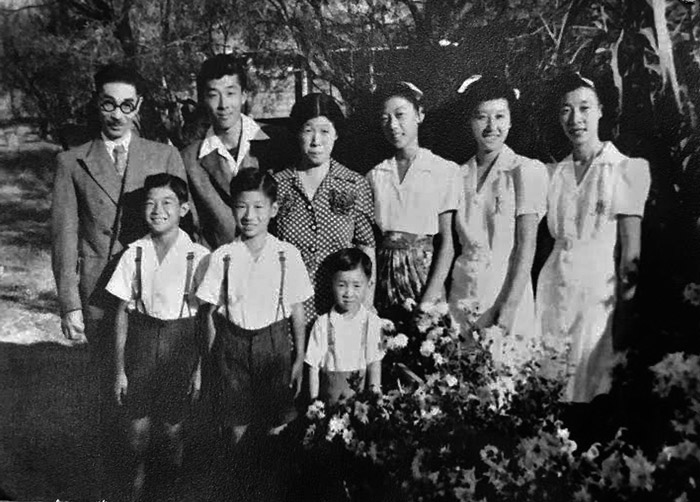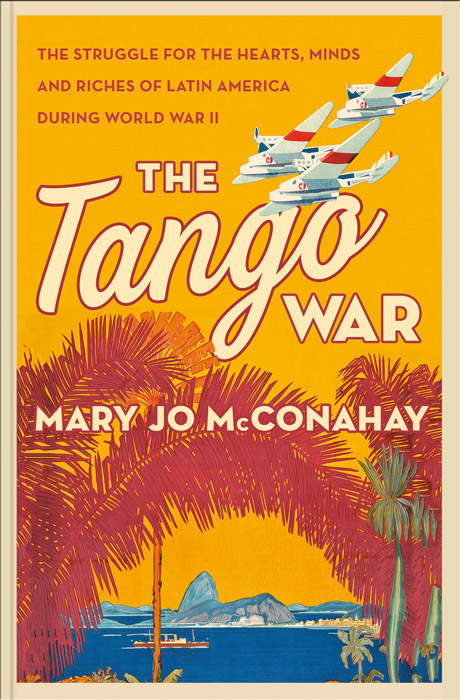The Tango War by Author Mary Jo McConahay
Prize-winning author Mary Jo McConahay presents her new book, The Tango War, The Struggle for the Hearts, Minds and Riches of Latin America During World War II
The fascinating, largely unknown story of how the global conflict affected countries from Mexico to Argentina, including Guatemala, and how the Axis and the Allies never took their eyes from each other, like dancers in a tango.
Presentations:
Tuesday, April 2, at Casa Herrera
4a. Avenida Norte, #9, Antigua Guatemala, at 5:30 pm
Introduction by Nancy McGirr, Founder/CEO Fotokids, former Reuters Staff Photographer for Central America.
——————————————————
Thursday, April 4, at Librería Sophos
Plaza Fontabella (4a Avenida 12-59), Zona 10, at 7:00 p.m.
Introduction by Dr. Regina Wagner, author of Los alemanes en Guatemala, (1828-1944).
In English. Books will be available.
————————————————————
“Gripping…a seasoned storyteller…” –The Wall Street Journal
“The mosaic writing style of Uruguayan author Eduardo Galeano…” –Los Angeles Review of Books
“Dramatic…” – Foreign Affairs
Excerpt from THE TANGO WAR
by Mary Jo McConahay
[On the secret U.S. wartime kidnap program, “Quiet Passages”]
My family slept behind me, piled close
Like a tribe camped at some ruinous place
Then I placed my tongue on the wall
To leave a humid mark before we left
José Watanabe, from “Wall,” in Flags behind the Fog (Banderas detrás de la niebla)
The U.S. forced rendition and removal program swept more than two thousand ethnic Japanese from their homes in Latin America and brought them to concentration camps in the United States. The given justification for this mass abduction was to prevent a fifth column from sabotaging the Allies. But the real reasons went deeper.
Like Germany, Japan maintained intense interest in Latin America as a market and a source of raw materials – Japan was second only to the United States as an importer of Peru’s primary export crop, cotton, for instance. Just as the wartime U.S. blacklist struck at German-owned firms in Latin America, prohibiting them to do business, the Allies wanted to restrain competing Japanese enterprises to clear the way for the friendliest possible post-war trade. And Latin governments were ready to take over the blacklisted businesses.
Racial prejudice was key — the same prejudice that drove the U.S. wartime imprisonment of 120,000 U.S. Japanese residents, two-thirds of them born in the United States, without charges or evidence of wrongdoing. Governments in Latin America could see that Washington was incarcerating its own “Japanese,” although they did not need to look to the North for lessons in racial bias. Latin politicians and elites often saw themselves as European – white – despite a mixed heritage with black and indigenous populations. In policy and inclination many were comfortable with discrimination, if not hostility, against Asians.
The most important reason of all for capturing ethnic Japanese out of Latin America, however, was that the United States urgently needed “Japanese” individuals to exchange for Americans held prisoner in Asia. Washington needed trade bait…
More than any other country, Peru collaborated with Washington in sending away its residents of Japanese ancestry. Successful entrepreneurs and social leaders were taken from a thriving community of thirty thousand. Of the twenty-two hundred Japanese sent to the United States from Latin America, about eighteen hundred came from Peru. Many were the best and brightest of the community.
FBI agents, diplomats, and U.S. military intelligence personnel looked for Peruvian Japanese who might be security risks. Not everyone on the hunt was fluent in Spanish. Sometimes denunciations were accepted at face value from suspicious neighbors or business rivals. Peruvian Japanese say that FBI agents combed newspapers to make their arrest lists, seeking men who played important roles in Japanese cultural, trade, education and self-help groups, even noting who attended social events. When detectives brought in the suspected subversives, there was little recourse to the law, although local officials were not above bribery to free a suspect if the price was right…
…Chuhei Shimomura, who owned a small import company, was arrested without charge, and there was no hearing. More than seventy years later Flor de Maria Shimomura remembers visiting her father at Lima’s forbidding Panoptico prison in 1943. A few days later, with a thousand other prisoners, Chuhei Shimomura boarded the oil-fired steamer Etolin, seconded from the Alaska Packers’ Association, newly painted with the word DIPLOMATE starboard and port.
“We went to the dock to see if they might have mercy,” Flor de Maria said. But no one was released. Her brother Carlos said the picture of those days “queda gravado,” remains engraved in the mind. With their mother, they watched the ship “until it disappeared…”
…In 2016, Kazushige, Kazuharu and Kazumu [Naganuma], came to my home in San Francisco, where they now live. In Peru they also had Spanish names, and when they began school in the States their older sister Kiyo gave them English names their teachers could easily pronounce: Jimmy, George and Tony. Today, however, they prefer to use the full Japanese names their parents gave them at birth.
Kazushige, the oldest, told me he had retired from work at the Japanese Tea Garden in Golden Gate Park, Kazuharu from a job at a printing firm, and Kazumu, the youngest at age 76, was a graphic designer and active soccer coach. Kazushige and Kazuharu had memories of many scenes of their childhoods, and over the years their sister Kiyo, who died in 2012, had filled in certain details. It was clear the brothers, the only survivors of seven siblings, wanted to keep the family story alive.

All of Iwaichi and Isoka Naganuma’s children were born in Peru and baptized Catholics with Spanish names and prominent Peruvian godparents. All were taken to a U.S. camp for “enemy aliens.” – Courtesy of Naganuma family.
The first time detectives knocked, Kazushige said, his father [Iwaichi] ran from a back door and repaired to the mountains outside Lima with their eldest brother, who was fifteen, because their father was afraid the youth would be arrested too. They hid for days, then returned. The scene repeated itself until FBI agents finally entered the house and stayed, so [Iwaichi] Naganuma gave himself up. Agents ordered him to report to the docks at Callao to board a U.S. Army transport, with his family if desired – the Peruvian government wanted to get rid of as many Japanese as possible. Parents and children packed a single trunk. Little did they know that their story would be that of almost all captured Peruvian Japanese, permanent exile from home. Peru would not take its “Japanese” back.
The Naganumas told me their father had come from Japan to Peru in 1910 on an agricultural labor contract and sent home for a picture bride. Iwaichi met their mother Isoka for the first time as she disembarked from her ship; without words, he wrapped a watch around her wrist as a wedding gift. Kazuharu remembered the family’s Callao house with its attached commercial laundry on Calle Sucre, “all hand wash, with big paddles and metal tanks and clothes and sheets hanging outside and a sewing room to make repairs.” [In Peru, the boys were baptized Catholic with Spanish names.]
In the 1930s the lives of the couple, Iwaichi [Luis] and Isoka, who often went by a Spanish name, Maria, were filled with work at the laundry, with children, and with tragedy, too. Their three-year old boy, Guillermo, “swallowed a pin,” perhaps a straight pin picked up from the laundry floor, or a decorative pin twisted off his cap, and choked on it. [A doctor could not save the boy.]
To hear them tell their story, the Naganuma boys thrived in the streets of pre-war Callao. Spanish was the language of play. They celebrated Peruvian holidays as well as undōkai, traditional Japanese sports festivals. “We had a big yard,” remembered Kazuharu. “A garden, dogs, cats, chickens.” Their father built a music studio. “I used to watch people dancing, mostly legs through the lower half of a swinging door, because I was still small.” When Kazushige was lucky, his sisters might take him along to the movies, to see a western like Santa Fe Trail with Errol Flynn and Ronald Reagan.
Once he saw an animated feature that made fun of Japanese, with a General Tojo-like figure wearing big black-rimmed glasses, “with buck teeth” and other stereotypical features (perhaps You’re a Sap, Mr. Jap, from Paramount). “I went home and talked about it, but I wasn’t offended,” Kazushige said. “I was thinking of it as a Peruvian kid.”
In 1947, the Naganumas, bedraggled and impoverished, suffering from tuberculosis, were released from the U.S. Justice Department concentration camp in Crystal City, Texas. The only one to return to Peru, briefly in 2016, has been Kazushige, to pick up the ashes of his brother who had died from swallowing a pin. In California Kazushige, Kazuharu and Kazumu had the ashes of their brother interred in the grave of their parents. The young Guillermo’s Japanese name, Kazuaki, was already on the tombstone. Their father had ordered it engraved, thinking until the end of the son he had left behind in Peru…
Check our website next month for another excerpt of this extraordinary book.
REVUE magazine article by Mary Jo McConahay
